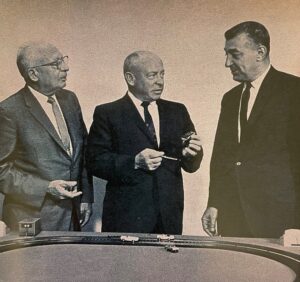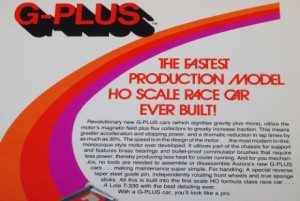The History of Aurora & AFX
By the fifties, America was moving firmly past the Second World War and into an era of unprecedented prosperity. More and more Americans felt they could afford some pleasant distractions. About this time Joseph and Gennaro Giammarino got together with John Cuomo and Abe Shikes to create a company that would become an icon of the American toy industry – Aurora Plastics Company.
 John Cuomo, Abe Shikes, and Joe Giammarino (photo courtesy of “Aurora Slot Cars” by Thomas Graham).
John Cuomo, Abe Shikes, and Joe Giammarino (photo courtesy of “Aurora Slot Cars” by Thomas Graham).
While you could fill a book with the history of this innovative business, we will focus on their contribution to slot cars and only briefly touch on some of their many accomplishments.
First, A Quick History of G+
 The original G+ Chassis was created by an R&D team based out of K&B Model Aircraft in Downey California. The members of the team were: John Wessels, John Cukras, Robert Bernhard, Jack Garcia, Fred “The Bear” Kessler and Jim Russell. The team was formed in 1971 as part of a strategy conceived by Russell to establish a “skunkworks” operation away from the Aurora offices in New York. This strategy was born of two conclusions he had reached in the years since he sold Russkit to Aurora in 1969 and moved to New York as manager of the Hobby division: first, that it was impossible, given the corporate culture and political nonsense then going on at Aurora, to get any breakthrough products out of R&D and second, Russell hated New York and was desperate to get back to California.
The original G+ Chassis was created by an R&D team based out of K&B Model Aircraft in Downey California. The members of the team were: John Wessels, John Cukras, Robert Bernhard, Jack Garcia, Fred “The Bear” Kessler and Jim Russell. The team was formed in 1971 as part of a strategy conceived by Russell to establish a “skunkworks” operation away from the Aurora offices in New York. This strategy was born of two conclusions he had reached in the years since he sold Russkit to Aurora in 1969 and moved to New York as manager of the Hobby division: first, that it was impossible, given the corporate culture and political nonsense then going on at Aurora, to get any breakthrough products out of R&D and second, Russell hated New York and was desperate to get back to California.
K&B was then part of Aurora and had some problems that needed to be addressed so Russell seized the opportunity and proposed that he go out there to help sort out K&B and in the process would manage the accessories part of the slot car business and develop a range of new products to take Model Motoring to the next level. He had long been unhappy with Model Motoring feeling it was simply an accessory for HO trains and, with his enthusiasm for motorsport, wanted to put more excitement and realism into it. Wessels had been part of the Russkit team during the 60’s and Cukras made a nasty habit of beating Team Russkit when few others could. Bernhard was a local slot car “hot shoe” from the San Fernando Valley racing scene and Jack Garcia was a well-known craftsman and fabricator. Wessels and Cukras were the “engineering” guys, Garcia did most of the model making, Bernhard was the go-fer/helper, The Bear did machine work and Jim contributed ideas and kept the group headed in the right direction – more or less.
So the team set out to do something special. Specifically, the goal from Russell was to create a new kind of chassis that would be lighter and faster than anything yet produced. They were working on an inline motor design in a monocoque chassis, a first for the hobby, and at one meeting around the famous “orange table”, Bernhard, then only 18 or 19 years old, showed the team an idea he had for using motor magnets to help stick cars to the track rail. The next morning the entire team was off like a rocket, out to adapt John’s discovery to their radical new chassis.
Later, once the chassis had been sorted out and it was clear that a patent was possible, it was John Wessels who suggested that Bob’s name go on the patent. All agreed and he was promptly paid one dollar for the privilege of having his name on the document. With that the first “ground effects” magnet car was created – certainly one of the most important developments in the history of HO racing. Russell named the new chassis: G+ for “gravity plus”. According to Cukras: “Jim was always coming up with the really dumb names”.
Meanwhile, back in New York, Jim Kirby, then product manager for T-Jets, was working away to develop a breakthrough for the line. (A little side story: Jim Kirby was brought out to New York from California by Jim Russell. Kirby had been hired by Russell at Russkit when he was very young. He was a hard worker and had a touch for R&D. He also made a decent living street racing on Van Nuys Blvd in the most beautiful Corvette in California.) When he and Walter Moe, VP of R&D flew out to California and saw what the little group had done he returned to New York and got to work attempting to use the technology on the T-Jet chassis.
The result was the MagnaTraction line. Aurora had a lot of parts to make the older, shortly to be outdated “Pancake” motored cars and they wanted to try to get some use out of them. Also, some of the New York R&D group questioned whether or not it was wise to pursue such high-performance levels – the cars may be getting “too fast”, they felt. However, Russell was convinced that there was no reason to expend any more effort on the old technology and that time was of the essence if they wanted to get the jump on Tyco. In the end, Moe and Chuck Diker decided to delay the introduction of the G+ indefinitely.
Although senior management agreed to show the G-Plus at the ’75 Hobby Show Walter Moe insisted that the price be more than doubled to hold down demand. This is the price sheet that John Cukras used to make that change. Note the discoloration over the “Net Price” for the two G-Plus cars. He had glued the revised prices in place then had them reprinted. The changed prices fell off over the years.
So it was that prior to the Hobby Show in January of 1975, Russell took the buyer from Sears aside and showed him the new chassis. The buyer was bowled over and insisted on being able to buy the new chassis right now. Armed with a fistful of prospective POs from the then world’s largest retailer, Russell went to Diker and Moe and politely suggested that maybe they should release G+ after all. The pair relented but Moe told Russell that they had to price it more than double what they had planned. This all happened just as the show was starting and Cukras was dispatched to change the prices from $3.85 to $8.50 on all of the price sheets. But even this couldn’t stop the G+ and it stole the show.
By the end of 1976, AFX sales hit their all-time high of about $45 million on the back of the stunning popularity of the new technology. Quite an increase from the roughly $15 million in sales for the line in 1970.
In spite of the success of the AFX range, Aurora was not doing well. Their decision to attack the toy market had hurt profitability and even when the toy products were hits, the TV expense and low-profit margins of selling to the mass merchants made it difficult for the company to make any money.
Nabisco let it be known that they wanted to unload the company. So in 1977, they sold Aurora to a British toy conglomerate. AFX was eventually purchased by Tomy and opened a new chapter in its history.
READ NEXT
The History of Russkit or The History of Racemasters
